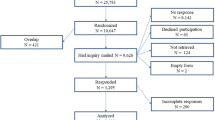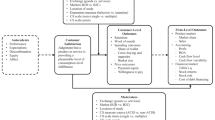Abstract
As a result of our inattention to the audit process, its antecedents, and its outcomes, the academic literature has lagged behind contemporary auditing practices as the demand for information systems audits has grown. To address this gap, we propose a model of IS audit satisfaction that includes auditor expertise (AE) and auditor role clarity (ARC) as antecedent variables that affect audit responsiveness (ARES) and audit reliability (AREL), which in turn affect audit satisfaction. We tested this model using survey data from 203 IS projects in South Korean public sector firms. Our results validate the significance of auditor characteristics (AE and ARC) and audit process variables (ARES and AREL) in shaping audit satisfaction. Implications for research and practice are discussed.





Similar content being viewed by others
References
Abdolmohammadi, M. J., & Boss, S. R. (2010). Factors associated with IT audits by the internal audit function. International Journal of Accounting Information Systems, 11(3), 140–151. doi:10.1016/j.accinf.2010.07.004.
Ali, S., & Green, P. (2012). Effective information technology (IT) governance mechanisms: an IT outsourcing perspective. Information Systems Frontier, 14(2). doi:10.1007/s10796-009-9183-y.
Anderson, J. C., & Gerbing, D. W. (1982). Some methods for respecting measurement models to obtain unidimensional construct measurement. Journal of Marketing Research, 9(4), 453–460.
Behn, B. K., Carcello, D., & Hermanson, R. H. (1997). The Determinants of Audit Client Satisfaction Among Client of Big 6. Accounting Horizons, 11(1), 24–27.
Behn, B. K., Carcello, J. V., Hermanson, D. R., & Hermanson, R. H. (1999). Client satisfaction and big 6 audit fees. Contemporary Accounting Research, 16(4), 587–608.
Behn, B. K., Choi, J. H., & Kang, T. (2008). Audit quality and properties of analyst earnings forecasts. Accounting Review, 83(2), 327–349. doi:10.2308/accr.2008.83.2.327.
Brazel, J. F. (2005). A measure of perceived auditor ERP systems expertise: development, assessment, and uses. Managerial Auditing Journal, 20(6), 619–631.
Brazel, J. F., & Agoglia, C. R. (2007). An examination of auditor planning judgements in a complex accounting information system environment. Contemporary Accounting Research, 24(4), 1059 − +. doi:10.1506/Car.24.4.1
Carcello, J. V., Hermanson, R. H., & McGrath, N. T. (1992). Audit quality attributes: per perceptions of audit partners, preparers, and financial statement users. Auditing, 11(1), 15–11.
Chan, D. Y., & Vasarhelyi, M. A. (2011). Innovation and practice of continuous auditing. International Journal of Accounting Information Systems, 12(2), 152–160. doi:10.1016/j.accinf.2011.01.001.
Cho, I., Changmin, L., Daul, S., Jaque, R., Sojung, K., Hyunmok, O., & Kyeonghee, O. (2008). Information systems audit legislation passed in Korea (pp. 1–6). December: Information Systems Control Journal Online.
Choi, Y. (2005). An empirical study on the efficacy of information systems audit in software development projects. National Information Policy, 11(1), 12.
Curtis, M. B., & Payne, E. A. (2008). An examination of contextual factors and individual characteristics affecting technology implementation decisions in auditing. International Journal of Accounting Information Systems, 9(2), 104–121. doi:10.1016/j.accinf.2007.10.002.
Curtis, M. B., & Viator, R. E. (2000). An investigation of multidimensional knowledge structure and computer auditor performance. Auditing, 19(2), 21.
Curtis, M. B., Jenkins, J., Bedard, J. C., & Deis, D. R. (2009). Auditors’ training and proficiency in information systems: a research synthesis. Journal of Information Systems, 23(1), 18.
De Haes, S., & Van Grembergen, W. (2008). An exploratory study into the design of an IT governance minimum baseline through Delphi research. Communications of AIS, 22, 443–458.
DeAngelo, L. E. (1981). Auditor size and audit quality. Journal of Accounting and Economics, 3, 183–199.
DeFond, M., & Zhang, J. (2014). A review of archival auditing research. Journal of Accounting & Economics, 58(2/3), 275–326. doi:10.1016/j.jacceco.2014.09.002.
DeLone, W. H., & McLean, E. R. (1992). Information systems success: the quest for the dependent variable. Information Systems Research, 3(1), 60–95.
DeLone, W. H., & McLean, E. R. (2003). The DeLone and McLean model of information systems success: a ten-year update. Journal of Management Information Systems, 19(4), 9–30.
Eisenhardt, K. M. (1989). Agency theory: an assessment and review. Academy of Management Review, 14(1), 57–74. doi:10.5465/AMR.1989.4279003.
Fornell, C., & Larcker, D. F. (1981). Evaluating structural equation models with unobservable variables and measurement error. Journal of Marketing Research, 81(1), 39–50.
Gefen, D., Wyss, S., & Lichtenstein, Y. (2008). Business familiarity as risk mitigation in software development outsourcing contract. MIS Quarterly, 32(3), 531--542.
Goo, J., & Hwang, G. (2005). A study on the determinants of service quality of information systems audit. Korean Manufacturing management Journal, 16(2), 33–55.
Grabski, S., Reveau, J. H., & West, S. (1987). A comparison of judgment, skills, and prompting effects between auditors and systems analysts. MIS Quarterly, 11(2), 151–161.
Grembergen, W. v., & Haes, S. D. (2008). Implementing information technology governance: Models, practices and cases. Hershey, PA: IGI PUBLISHING.
Hunton, J. E., Wright, A. M., & Wright, S. (2004). Are financial auditors overconfident in their ability to assess risks associated with enterprise resource planning systems? Journal of Information Systems, 18(2), 7–28.
Janvrin, D., Bierstaker, J., & Lowe, D. J. (2009). An investigation of factors influencing the use of computer-related audit procedures. Journal of Information Systems, 23(1), 97–118.
Kellar, S. A. (2009). Information systems: A concise study: Prentice hall of India.
Kelly, T., & Margheim, L. (1990). The impact of time budget pressure, personality, and leadership variables on dysfuctional auditor behavior. Auditing : A Journal of Practice and Theory, 9(2).
Kim, D., Kim, H., & Ahn, Y. (2005). The effect of information systems audit pattern on the audit quality and customer satisfaction. Korea IT Service Journal, 4(2), 23–32.
Kim, D., Yang, K., & Kim, H. (2006). A study on the effect of the information system audit fidelity on the customer satisfaction and project performance. Korea IT Service Journal, 5(2), 59–78.
Kim, D., Kim, H., Kang, J., & Yang, K. (2007). A study on the effectiveness factors for information system audit and project performance. National Information Policy, 14(1), 44–67.
Kim, H.-J., Mannino, M., & Nieschwietz, R. J. (2009). Information technology acceptance in the internal audit profession: impact of technology features and complexity. International Journal of Accounting Information Systems, 10(4), 214–228. doi:10.1016/j.accinf.2009.09.001.
Kirsch, L. J., Sambamurthy, V., Ko, D. G., & Purvis, R. L. (2002). Controlling information systems development projects: the view from the client. Management Science, 48(4), 484–498.
Kohli, A. K. (1985). Some unexplored supervisory behaviors and their influence on salespeople’s role clarity, specific self-esteem, job satisfaction, and motivation. Journal of Marketing Research, 12(November), 424–433.
Korunka, C., Scharitzer, D., Carayon, P., & Sainfort, F. (2003). Employee strain and job satisfaction related to an implementation of quality in a public service organization: a longitudinal study. Work and Stress, 17(1), 52–72. doi:10.1080/0267837031000109526.
Lacity, M. C., & Willcocks, L. P. (1998). An empirical investigation of information technology sourcing practices: lessons from experience. MIS Quarterly, 22(3), 363--408.
Malone, C. F., & Roberts, R. W. (1996). Factors associated with the incidence of reduced audit quality behaviors. Auditing: A Journal of Practice and Theory, 15(2), 49–64.
Mazza, T., Azzali, S., & Fornaciari, L. (2014). Audit quality of outsourced information technology controls. Managerial Auditing Journal, 29(9), 1–39.
McFarlan, F. W. (1981). Portfolio approach to information systems. Harvard Business Review, 59, 9.
McKeen, J. D., Guimaraes, T., & Wetherbe, J. C. (1994). The relationship between user participation and user satisfaction: an investigation of four contingency factors. MIS Quarterly, 18(4), 427–451.
Morris, B. W., & Pushkin, A. B. (1995). Determinants of information systems audit involvement in EDI systems development. Journal of Information Systems, 9(2), 111–128.
Mukherjee, A., & Maihotra, N. (2006). Does role clarity explain employee-perceived service quality? International Journal of Service Industry Management, 17(5), 444–473. doi:10.1108/09564230610689777.
Muliawan, A. D., Green, P. F., & Robb, D. A. (2009). The turnover intentions of information systems auditors. International Journal of Accounting Information Systems, 10(3), 117–136. doi:10.1016/j.accinf.2009.03.001.
Nidumolu, S. R. (1995). The effect of coordination and uncertainty on software project performance: residual performance risk as an intervening variable. Information Systems Research, 6(3), 29.
Olson, D. (2004). Introduction to project management 2nd ed. New York: Irwin: McGraw-Hill.
Palmrose, Z.-V. (1988). An analysis of auditor litigation and audit service quality. Accounting Review, 63, 55–73.
Parasuraman, A., Zeithaml, V. A., & Berry, L. L. (1988). SERVQUAL: a multiple-item scale for measuring consumer perceptions of service qality. Journal of Retailing, 64(1), 12--40.
Pathak, J., Lind, M., & Abdolmohammadi, M. (2010). E-commerce audit judgment expertise: does expertise in system change management and information technology auditing mediate E-commerce audit judgment expertise? Informatica Economica, 14(1), 5–20.
Pavlou, P. A., Huigang, L., & Yajiong, X. (2007). UNDERSTANDING AND MITIGATING UNCERTAINTY IN ONLINE EXCHANGE RELATIONSHIPS: a PRINCIPAL–AGENT PERSPECTIVE. MIS Quarterly, 31(1), 105–136.
Podsakoff, P., MacKenzie, S., Lee, J., & Podsakoff, N. (2003). Common method biases in behavioral research: a critical review of the literature and recommended remedies. Journal of Applied Psychology, 88(5), 879–903.
Redmill, F. (1997). Software projects: evolutionary vs. Big-Bang Delivery. New York: Wiley.
Rittenberg, L., & Charles, P. (1978). The internal auditor’s role in MIS developments. MIS Quarterly, 2(4), 47–57.
Rosacker, K. M., & Olson, D. L. (2010). An empirical assessment of IT project selection and evaluation methods in state government. Project Management Journal, 39(1), 49–58.
Sainfort, F. Pascale, C., M. J. Smith, Y. J. Yen, J. Lund, A. Taveira, James, C., P. Hoonakker, C. Korunka. (2000). The development and application of an instrument for measurement of quality institutionalization: IEA 2000/HFES 2000.
Sambamurthy, V., & Zmud, R. W. (1999). Arrangements for information technology governance: a theory of multiple contingencies. MIS Quarterly, 23(2), 261–290. doi:10.2307/249754.
Samelson, D., Lowenshon, S., & Johnson, L. E. (2006). The determinants of perceived audit quality and auditee satisfaction in local government. Journal of Public Budgeting, Accounting and Financial Management, 18(2), 139–166.
Sarantis, D., Charalabidis, Y., & Askounis, D. (2006). A goal-driven management framework for electronic government transformation project implementation. Governmental Information Quarterly, 28(2), 117–128.
Sayana, S. A. (2002). IS audit process. Information Systems Control Journal, 1.
Steiger, J. H. (2007). Understanding the limitations of global fit assessment in structural equation modeling. Personality and Individual Differences, 42(5), 98.
Suh, S. (2002). The effect of IT audit on national administration network project. Seoul: National information society Agency.
Susan, J. L. (2009). CISA® review manual. IL: ISACA.
Sutton, S., & Lampe, J. C. (1991). A framework for evaluating process quality for audit engagement. Accounting and Business Research, 21(83), 275–288.
Teo, T. S., & Ranganathan, C. (2003). Leveraging IT resources and capabilities at the housing and development board. Journal of Strategic Information Systems, 12(3), 21.
UN. (2012). 2010 United Nations E-Government Survey Award. 2012, from http://www.unpan.org/DPADM/UNPSDayAwards/UNEGovSurveyAwards/tabid/1309/language/en-US/Default.aspx,
Wallace, L., Hui, L., & Cefaratti, M. A. (2011). Information security and Sarbanes-Oxley compliance: an exploratory study. Journal of Information Systems, 25(1), 185–211. doi:10.2308/jis.2011.25.1.185.
Watkins, A. L., Hillison, W., & Morecroft, S. E. (2004). Audit quality: a synthesis of theory and emprical evidence. Journal of Accounting Literature, 23, 153--194.
Weber, R. (1998). Information systems control and audit. New York: Prentice Hall.
Weidenmier, M. L., & Ramamoorti, S. (2006). Research opportunities in information technology and internal auditing. Journal of Information Systems, 20(1), 205–219.
Weill, P., & Ross, J. (2005). A matrixed approach to designing IT governance. Mit Sloan Management Review, 46(2), 26.
Willcocks, L. D. F. G. I. (1997). Managing IT as a strategic resources. London, UK: McGraw-Hill.
Yetton, P., Martin, A., Sharma, R., & Johnston, K. (2000). A model of information systems development project performance. Information Systems Journal, 10, 17.
Zhao, J. J., & Zhao, S. Y. (2010). Opportunities and threat: a security assessment of state e-government websites. Governmental Information Quarterly, 27(1), 49–56.
Acknowledgments
The authors wish to thank Jaque Rim (Executive Principal of National Information Agency) and the researchers at the department of IS Audit in NIA, South Korea, for their cooperation and support.
Author information
Authors and Affiliations
Corresponding author
Rights and permissions
About this article
Cite this article
Kim, S.L., Teo, T.S., Bhattacherjee, A. et al. IS auditor characteristics, audit process variables, and IS audit satisfaction: An empirical study in South Korea. Inf Syst Front 19, 577–591 (2017). https://doi.org/10.1007/s10796-015-9612-z
Published:
Issue Date:
DOI: https://doi.org/10.1007/s10796-015-9612-z




